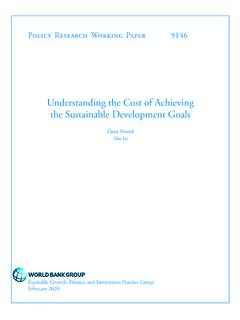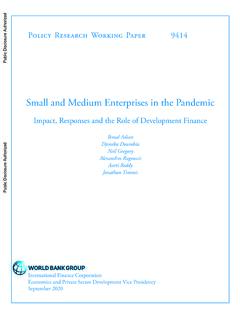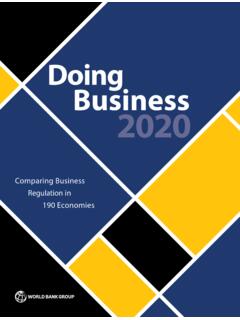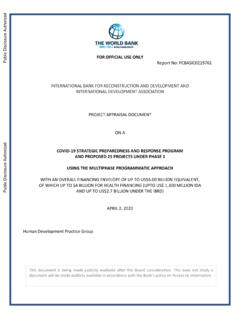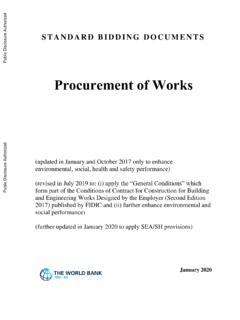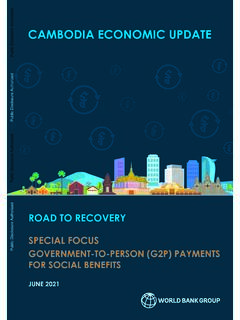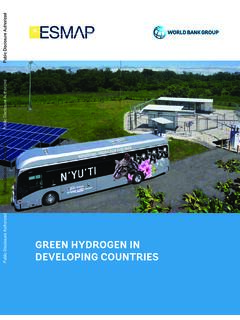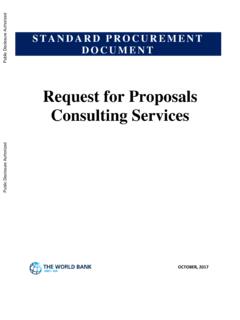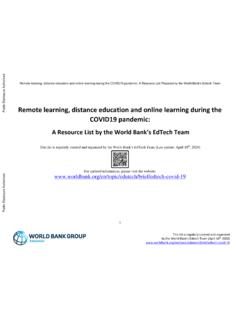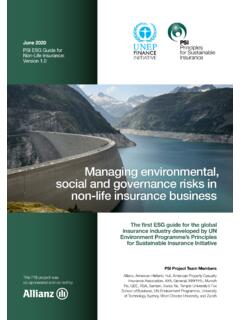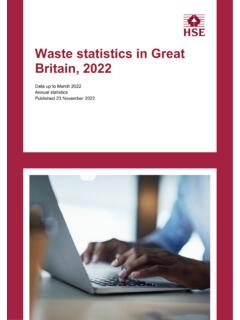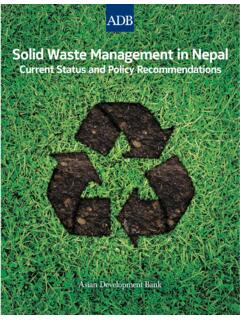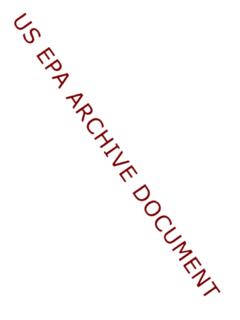Transcription of WHAT A WASTE: A GLOBAL REVIEW OF SOLID WASTE …
1 WHAT A WASTEA GLOBAL REVIEW of SOLID WASTE ManagementKNOWLEDGE PAPERSFor more information about the Urban Development Series, contact: Urban Development and Local Government UnitSustainable Development NetworkThe World Bank1818 H Street, NWWashington, DC, 20433 USAE mail: 2012, No. 15 WHAT A WASTE : A GLOBAL REVIEW OF SOLID WASTE MANAGEMENTP ublic Disclosure AuthorizedPublic Disclosure AuthorizedPublic Disclosure AuthorizedPublic Disclosure AuthorizedCover photo on right and on this page: Conakry landfill, Guinea (Charles Peterson photographer).Cover photo on far left: separate containers for recyclables and non-recyclables, Barcelona, Spain (Perinaz Bhada-Tata photographer).Previous Knowledge Papers in This SeriesLessons and Experiences from Mainstreaming HIV/AIDS into Urban/Water (AFTU1 & AFTU2) ProjectsNina Schuler, Alicia Casalis, Sylvie Debomy, Christianna Johnnides, and Kate Kuper, September 2005, No. 1 Occupational and Environmental Health Issues of SOLID WASTE Management: Special Emphasis on Middle and Lower-Income CountriesSandra Cointreau, July 2006, No.
2 2A REVIEW of Urban Development Issues in Poverty Reduction StrategiesJudy L. Baker and Iwona Reichardt, June 2007, No. 3 Urban Poverty in Ethiopia: A Multi-Faceted and Spatial PerspectiveElisa Muzzini, January 2008, No. 4 Urban Poverty: A GLOBAL ViewJudy L. Baker, January 2008, No. 5 Preparing Surveys for Urban Upgrading Interventions: Prototype Survey Instrument and User GuideAna Goicoechea, April 2008, No. 6 Exploring Urban Growth Management: Insights from Three CitiesMila Freire, Douglas Webster, and Christopher Rose, June 2008, No. 7 Private Sector Initiatives in Slum UpgradingJudy L. Baker and Kim McClain, May 2009, No. 8 The Urban Rehabilitation of the Medinas: The World Bank Experience in the Middle East and North AfricaAnthony G. Bigio and Guido Licciardi, May 2010, No. 9 Cities and Climate Change: An Urgent AgendaDaniel Hoornweg, December 2010, No. 10 Memo to the Mayor: Improving Access to Urban Land for All Residents Fulfilling the PromiseBarbara Lipman, with Robin Rajack, June 2011, No.
3 11 Conserving the Past as a Foundation for the Future: China-World Bank Partnership on Cultural Heritage ConservationKatrinka Ebbe, Guido Licciardi and Axel Baeumler, September 2011, No. 12 Guidebook on Capital Investment Planning for Local GovernmentsOlga Kaganova, October 2011, No. 13 WHAT A WASTEA GLOBAL REVIEW of SOLID WASTE ManagementDaniel Hoornweg and Perinaz Bhada-Tata March 2012, No. 15 KNOWLEDGE PAPERSC opyright World Bank, 2012 All rights reserved Urban Development & Local Government UnitWorld Bank 1818 H Street, NW Washington, DC 20433 USA publication is a product of the staff of the World Bank Group. It does not necessarily reflect the views of the Executive Directors of the World Bank or the governments they represent. The World Bank does not guarantee the accuracy of the data included in this work. This note is provided for information only. The World Bank has no responsibility for the persistence or accuracy of URLs and citations for external or third-party sources referred to in this publication, and does not guarantee that any content is, or will remain, accurate or Development Series Produced by the World Bank s Urban Development and Local Government Unit of the Sustainable Development Network, the Urban Development Series discusses the challenge of urbanization and what it will mean for developing countries in the decades ahead.
4 The Series aims to explore and delve more substantively into the core issues framed by the World Bank s 2009 Urban Strategy Systems of Cities: Harnessing Urbanization for Growth and Poverty Alleviation. Across the five domains of the Urban Strategy, the Series provides a focal point for publications that seek to foster a better understanding of (i) the core elements of the city system, (ii) pro-poor policies, (iii) city economies, (iv) urban land and housing markets, (v) sustainable urban environment, and other urban issues germane to the urban development agenda for sustainable cities and viiAcknowledgements viiiExecutive Summary ixAbbreviations and Acronyms xiCountry classification According to Region xiiCountry classification According to Income xiii1. Introduction 12. GLOBAL WASTE Management Practices 43. WASTE Generation 84. WASTE Collection 135. WASTE Composition 166. WASTE Disposal 227. WASTE and the Environment 25A Note on the Reliability of SOLID WASTE Data 32 TABLE OF CONTENTSM axim Tupikov DEVELOPMENT SERIES KNOWLEDGE PAPERSA nnexesA.
5 Map of Regions 36B. Map of Income Distribution 38C. Availability of MSW Data by Country 40D. Countries Excluded for Lack of Data 45E. Estimated SOLID WASTE Management Costs 46F. MSW Generation Data for Cities Over 100,000 47G. MSW Collection Data for Cities Over 100,000 63H. MSW Disposal Methods for Cities Over 100,000 71I. MSW Composition Data for Cities Over 100,000 78J. MSW Generation by Country Current Data and Projections for 2025 80K. MSW Collection Rates by Country 84L. MSW Disposal Methods by Country 87M. MSW Composition by Country 90N. IPCC classification of MSW Composition 93O. The GLOBAL City Indicators Program 94 References 95 WHAT A WASTE : A GLOBAL REVIEW OF SOLID WASTE MANAGEMENTvList of Tables1. Comparison of SOLID WASTE management practices by income level 52. Generators and types of SOLID WASTE 73. Current WASTE generation per capita by region 94. WASTE generation projections for 2025 by region 105.
6 Current WASTE generation per capita by income level 106. WASTE generation projections for 2025 by income 117. Sources for 2025 projections of SOLID WASTE generation 128. Average MSW generation rates by income 129. Types of WASTE and their sources 1610. Types of WASTE composition by income level 1911. MSW disposal by income 2312. MSW disposal in two contrasting regions 2413. Landfill classifications 2914. Landfill methane emissions and total GHG emissions for selected countries 3015. Technical GHG mitigation opportunities by WASTE management component 31 List of Figures1. WASTE generation by region 92. WASTE generation by income level 113. Urban WASTE generation by income level and year 124. WASTE collection rates by income 155. WASTE collection rates by region 156. WASTE composition in China 177. GLOBAL SOLID WASTE composition 178. WASTE composition by income 199. SOLID WASTE composition by income and year 2010.
7 WASTE composition by region 2111. Total MSW disposed of worldwide 2212. Low-income countries WASTE disposal 2413. Upper middle-income countries WASTE disposal 2414. WASTE hierarchy 27 List of Boxes1. What a WASTE 1999: What s changed (and what hasn t) in the last decade 22. Definitions of Municipal SOLID WASTE 43. Components of an Integrated SOLID WASTE Management Plan 254. Integrated Sustainable WASTE Management Framework 26 SOLID WASTE management is the one thing just about every city government provides for its residents. While service levels, environ-mental impacts and costs vary dramatically, SOLID WASTE management is arguably the most important municipal service and serves as a prerequisite for other municipal action. Currently, world cities generate about billion tonnes of SOLID WASTE per year. This volume is expected to increase to billion tonnes by 2025. WASTE generation rates will more than double over the next twenty years in lower income countries.
8 Globally, SOLID WASTE management costs will increase from today s annual $ billion to about $ billion in 2025. Cost increases will be most severe in low income countries (more than 5-fold increases) and lower-middle income countries (more than 4-fold increases). The GLOBAL impacts of SOLID WASTE are growing fast. SOLID WASTE is a large source of methane, a powerful GHG that is particularly impactful in the short-term. The recycling industry, with more than two million informal WASTE pickers, is now a GLOBAL business with international markets and extensive supply and transportation networks. Locally, uncollected SOLID WASTE contributes to flooding, air pollution, and public health impacts such as respiratory ailments, diarrhea and dengue fever. In lower income country cities SOLID WASTE management is usually a city s single largest budgetary report you have before you is an important one that provides a quick snapshot of the state of today s GLOBAL SOLID WASTE management practices.
9 A credible estimate is made for what the situation will look like in 2025. The findings are sobering. Improving SOLID WASTE management, especially in low income countries, is an urgent priority. Hopefully, this report will contribute to the dialogue that leads to much-needed KyteVice President and Head of Network, Sustainable DevelopmentThe World BankFOREWORD ITC landfill and recycling center, Ankara, Turkey Photo: Simone D. McCourtie/World BankPhoto: Perinaz Bhada-Tata Ghabawi landfill, Amman, JordanAcknowledgementsThis report was written by Daniel Hoornweg and Perinaz Bhada-Tata; and managed by Abha Joshi-Ghani, Manager of the Urban Development and Local Government Unit and Zoubida Allaoua, Director of the Finance, Economics and Local Government Department. The WASTE and Climate Change section is from Charles Peterson. The authors would like to thank Christa Anderson, Julianne Baker Gallegos, Carl Bartone, Marcus Lee, Catalina Marulanda, John Norton, Charles Peterson, Paul Procee, and Sintana Vergara for their useful feedback and comments.
10 The report was also discussed and reviewed by the World Bank s WASTE Management Thematic Group. Adelaide Barra, Xiaofeng Li, Jeffrey Lecksell and Claudia Lorena Trejos Gomez provided support and research assistance. EXECUTIVE SUMMARYAs the world hurtles toward its urban future, the amount of municipal SOLID WASTE (MSW), one of the most important by-products of an urban lifestyle, is growing even faster than the rate of urbanization. Ten years ago there were billion urban residents who generated about kg of MSW per person per day ( billion tonnes per year). This report estimates that today these amounts have increased to about 3 billion residents generating kg per person per day ( billion tonnes per year). By 2025 this will likely increase to billion urban residents generating about kg/capita/day of municipal SOLID WASTE ( billion tonnes per year). Municipal SOLID WASTE management is the most important service a city provides; in low-income countries as well as many middle-income countries, MSW is the largest single budget item for cities and one of the largest employers.
